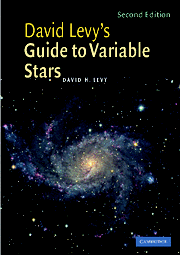Book contents
- Frontmatter
- Contents
- Foreword to the first edition
- Preface
- Acknowledgments
- Part I Getting to know the sky
- Part II Getting to know the variables
- 5 Meeting the family
- 6 Getting started with Cepheids
- 7 Algol, the demon of autumn
- 8 How to estimate a variable
- 9 Names and records
- 10 How your observations help us understand a variable star
- 11 Observing hints
- 12 Observing with CCDs
- 13 Stately and wonderful
- 14 Stars of challenge
- 15 Bright, easy, and interesting
- 16 Betelgeuse: easy and hard
- 17 Not too regular
- 18 Nova? What nova?
- 19 Supernovae
- 20 Clyde Tombaugh's star and the family of cataclysmic variables
- 21 A nova in reverse?
- 22 RU Lupi?
- 23 Orion, the star factory
- 24 Other variable things
- 25 The Sun
- Part III Suggested variables for observation throughout the year
- Part IV A miscellany
- Index
10 - How your observations help us understand a variable star
from Part II - Getting to know the variables
Published online by Cambridge University Press: 05 August 2012
- Frontmatter
- Contents
- Foreword to the first edition
- Preface
- Acknowledgments
- Part I Getting to know the sky
- Part II Getting to know the variables
- 5 Meeting the family
- 6 Getting started with Cepheids
- 7 Algol, the demon of autumn
- 8 How to estimate a variable
- 9 Names and records
- 10 How your observations help us understand a variable star
- 11 Observing hints
- 12 Observing with CCDs
- 13 Stately and wonderful
- 14 Stars of challenge
- 15 Bright, easy, and interesting
- 16 Betelgeuse: easy and hard
- 17 Not too regular
- 18 Nova? What nova?
- 19 Supernovae
- 20 Clyde Tombaugh's star and the family of cataclysmic variables
- 21 A nova in reverse?
- 22 RU Lupi?
- 23 Orion, the star factory
- 24 Other variable things
- 25 The Sun
- Part III Suggested variables for observation throughout the year
- Part IV A miscellany
- Index
Summary
What happens to observations once an observer has submitted them to a variable-star organization like the AAVSO? It is possible to see how a particular observation compares to other data, and how it fits into measuring how a star is behaving.
According to Elizabeth Waagen, long-time assistant to the director of the AAVSO, here are the steps involved in processing an observation.
Reporting observations
(1) After making an observation, you can send it to AAVSO through its website www.aavso.org, using a program called “WebObs.” (That's how I do it.) Alternatively, you can send in observations via email. Emailed observations are automatically checked by the AAVSO for errors or omissions. A third method is the classic paper report form which, when received at AAVSO headquarters, is entered into the AAVSO database.
(2) All observations sent electronically can be viewed on the website www.aavso.org. Click on “Access Data” and “Light Curve Generator” or go directly to http://www.aavso.org/data/lcg/. Soon you will see a plot of recent observations that will show a star's light curve, the actual story of the star's behavior.
The light curve that you examine of recent data on the AAVSO website is a “quick look” representation of the data. It might come with a notice that the data have not been “validated,” meaning that the data points have not yet passed the AAVSO's strict quality control. Each one is plotted against others and added to the star's light curve.
- Type
- Chapter
- Information
- David Levy's Guide to Variable Stars , pp. 49 - 51Publisher: Cambridge University PressPrint publication year: 2005

